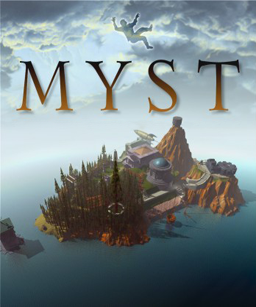
Myst is an adventure video game designed by Rand and Robyn Miller. It was developed by Cyan, Inc., published by Broderbund, and first released in 1993 for the Macintosh. In the game, the player travels via a special book to a mysterious island called Myst. The player interacts with objects and traverses the environment by clicking on pre-rendered imagery. Solving puzzles allows the player to travel to other worlds ("Ages"), which reveal the backstory of the game's characters and help the player make the choice of whom to aid.

Riven: The Sequel to Myst is a puzzle adventure video game, the second in the Myst series of games. Developed by Cyan Worlds, it was initially published by Red Orb Entertainment, a division of Broderbund. Riven was distributed on five compact discs and released for Mac and Windows personal computers on October 31, 1997, in North America; it was later released on a single DVD-ROM in 1998. Riven was also ported to several other platforms. The story of Riven is set after the events of Myst. Having been rescued from the efforts of his sons, Atrus enlists the help of the player character to free his wife from his power-hungry father, Gehn. Riven takes place almost entirely on the Age of Riven, a world slowly falling apart due to Gehn's destructive rule.

Discworld II: Missing Presumed...!? is a 1996 point-and-click adventure game based on Terry Pratchett's series of fantasy novels set on the mythical Discworld, and sequel to the 1995 video game of the same name. The story sees players assume the role of Rincewind the "wizzard" as he becomes burdened with the task of finding Death and coercing him out of an impromptu retirement and back into his regular duties. The game's plot borrows from a number of Discworld books, including key elements from Reaper Man and Moving Pictures.

Landstalker: The Treasures of King Nole is an action role-playing that was developed by Climax Entertainment and released for the Sega Genesis in 1992 in Japan and 1993 elsewhere. Players take on the role of the treasure hunter Nigel as he navigates a three-dimensional world through an isometric viewpoint, solving puzzles and fighting enemies.

Magic Carpet is a 3D flying video game developed by Bullfrog Productions and published by Electronic Arts in 1994 for MS-DOS, PlayStation, and Sega Saturn platforms. Its graphics and gameplay were considered innovative and technically impressive at the time of its release.

Mansion of Hidden Souls, called Tale of the Dream Mansion in Japan, and Yumemi Mystery Mansion in Europe, is an adventure video game released for the Sega CD, developed by System Sacom and published by Sega in Japan and PAL regions and by Vic Tokai in North America. It has a similar format to other adventure computer games such as Myst, Uninvited and D. It was first released on December 10, 1993, in Japan and then in February 1994 in North America. The PAL version followed soon a month after North America.
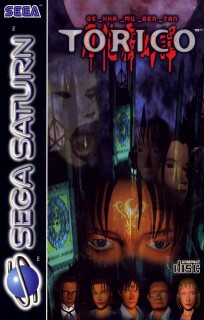
Lunacy, released in Europe as Torico and in Japan as Gekka Mugentan Torico, is an adventure game developed by System Sacom and published by Sega for the Sega Saturn in 1996. Lunacy is an interactive movie adventure consisting of a long series of interconnecting full motion video (FMV) sequences, much like The 7th Guest and System Sacom's earlier Saturn game, Mansion of Hidden Souls. The game is about a man named Fred who wanders around the City of Mists trying to uncover his forgotten identity. His forehead bears the imprint of a strange symbol, which seems to be the source of his amnesia. He travels to a city, where he encounters strange events and a man named Lord Gordon who rules the town with an iron fist and plays cruel games with the town's inhabitants.
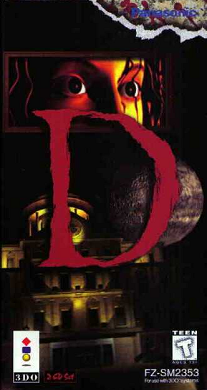
D is a horror-themed interactive movie and adventure game developed by Warp and directed by Kenji Eno. It was first published by Panasonic for the 3DO Interactive Multiplayer in 1995, later being ported to the Sega Saturn, PlayStation, and MS-DOS. The story follows Laura Harris as she goes to investigate a hospital after learning her father went on a mass murdering spree and barricaded himself inside. The hospital morphs into a castle upon her arrival, which she must explore to find her father. The player controls Laura through computer generated full-motion video (FMV) sequences, and must complete the game within two hours without a save or pause function.

Atlantis: The Lost Tales is a 1997 fantasy adventure video game developed and published by Cryo Interactive Entertainment. Interplay Productions published the game in North America, where it released on September 30, 1997. The game is named after its initial and most important setting, Atlantis. It is the first in a Myst-like series, and was followed by Atlantis II, Atlantis III: The New World, Atlantis Evolution and The Secrets of Atlantis: The Sacred Legacy.

Dark Savior is a 3D mixed-genre video game for the Sega Saturn created by Climax Entertainment. It was referred to by GameSpot as a sequel to the developer's game for the Sega Mega Drive/Genesis, Landstalker: The Treasures of King Nole, even though the games' storylines are unrelated and their gameplay is considerably different.

Mary Shelley's Frankenstein is an action platformer video game based on the 1994 film of the same name, an adaptation of Mary Shelley's 1818 novel Frankenstein; or, The Modern Prometheus.
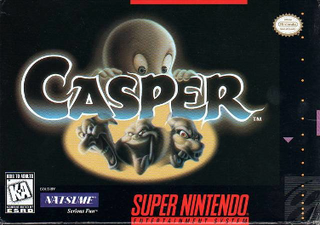
Casper is a series of action-adventure games based on the 1995 film of the same name. Two different games were released in 1996 and 1997 for the Super Nintendo Entertainment System, by different publishers, in different regions. A third game was released for the 3DO, Sega Saturn, PlayStation, and Game Boy Color, published by Interplay Productions. There was also a Game Boy game developed by Bonsai. A PC game, Casper: The Interactive Adventure, and a Game Boy Advance game, simply titled Casper, were released in 1997 and 2002 respectively serving as sequels.
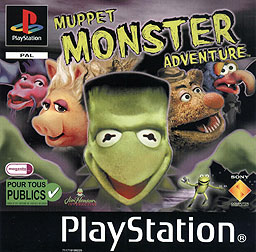
Muppet Monster Adventure is a platform game for the Sony PlayStation, developed by Magenta Software in 2000, and published by Sony Computer Entertainment in Europe and Midway Home Entertainment in North America.
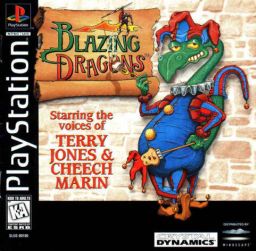
Blazing Dragons is a point-and-click adventure game developed by the Illusions Gaming Company and published by Crystal Dynamics. It is based on the television series of the same name and was released for the PlayStation and Sega Saturn in late 1996.

Frankenstein's Monster is a platform game developed for the Atari 2600 video game console, based on Mary Shelley's 1818 novel Frankenstein; or, The Modern Prometheus . It was released by Data Age in 1983.

Jewels of the Oracle is a 1995 adventure game developed by ELOI Productions and published by Discis Knowledge Research Inc. It was released on Macintosh, PlayStation, Sega Saturn, and Windows. A sequel developed by Bardworks and published by Hoffman and Associates was released in 1998 entitled Jewels II: The Ultimate Challenge.

Karma: Curse of the 12 Caves is a 1995 FMV adventure game. In 1998, DreamCatcher Interactive re-released the game as Quest for Karma. The game was released in Japan for PlayStation and Sega Saturn as Takuramakan.

Mummy: Tomb of the Pharaoh is a point-and-click adventure video game released on August 31, 1996, by Interplay Productions on Windows and by MacPlay, a division of Interplay Productions at the time, on Macintosh. It is a sequel to Frankenstein: Through the Eyes of the Monster. The game was developed by Amazing Media, directed and produced by Jeff McDonald, Keith Metzger, and Loring Casartelli, written by McDonald and Metzger, and composed by Márcio Câmara. Malcolm McDowell stars as Stuart Davenport, one of the main characters of the game.

Swagman is a 1997 action-adventure video game developed by Core Design and published by Eidos Interactive in Europe for the Sega Saturn and in North America for the PlayStation. In the game, players assume the role of Zack and Hannah to free the imprisoned Dreamflight fairies and stop the villain Swagman from unleashing his horde of monsters upon the world, whose inhabitants cannot wake up from their nightmares. The title was developed in conjunction with other projects at Core Design, taking influence from the works of Tim Burton. Versions for both the 32X and Atari Jaguar CD were announced but not released. It was received with mostly positive reception from critics.
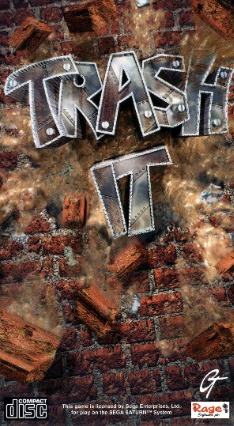
Trash It is a puzzle-platform game developed by Rage Software and published by GT Interactive in July 1997. It was released in PAL-territories only for MS-DOS, PlayStation, and Sega Saturn.




















